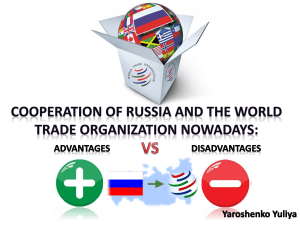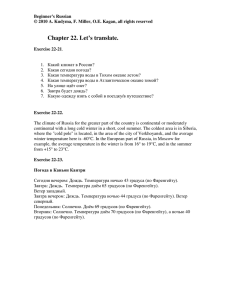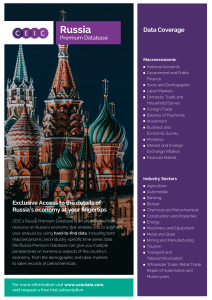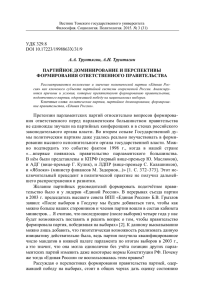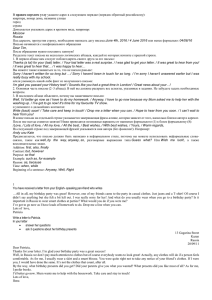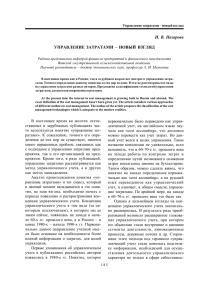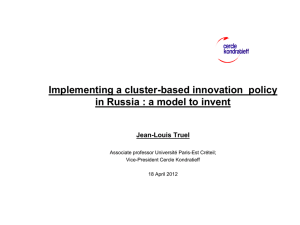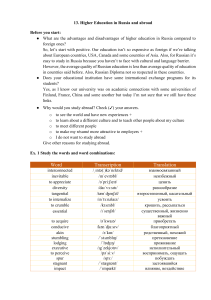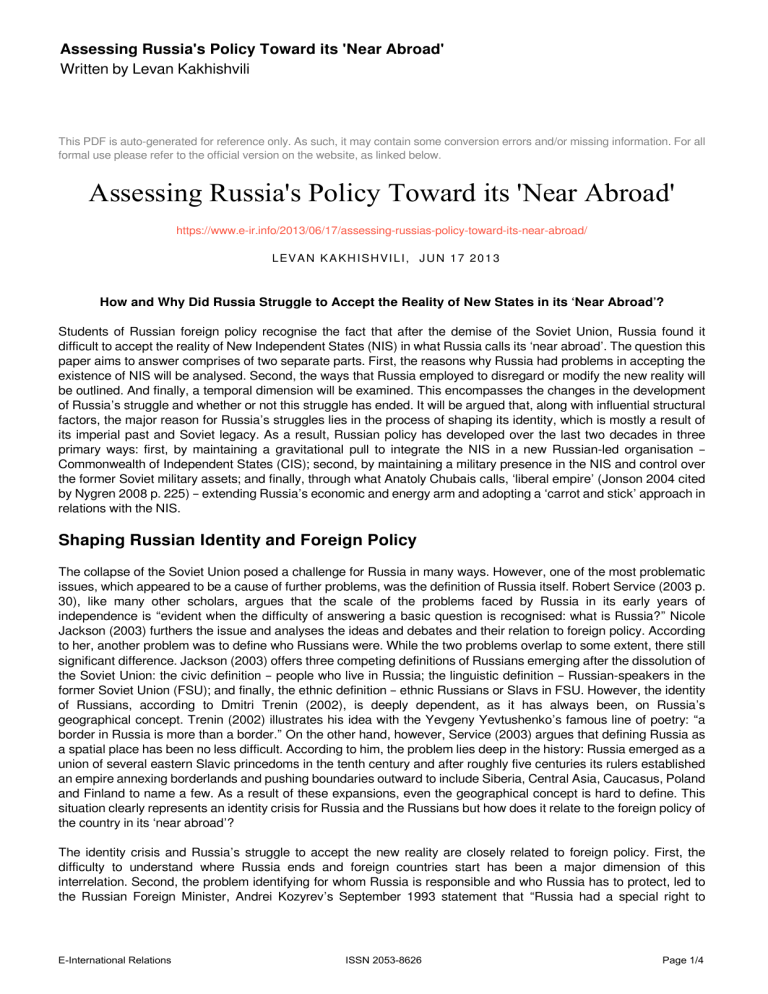
Assessing Russia's Policy Toward its 'Near Abroad' Written by Levan Kakhishvili This PDF is auto-generated for reference only. As such, it may contain some conversion errors and/or missing information. For all formal use please refer to the official version on the website, as linked below. Assessing Russia's Policy Toward its 'Near Abroad' https://www.e-ir.info/2013/06/17/assessing-russias-policy-toward-its-near-abroad/ LEVAN KAKHISHVILI, JUN 17 2013 How and Why Did Russia Struggle to Accept the Reality of New States in its ‘Near Abroad’? Students of Russian foreign policy recognise the fact that after the demise of the Soviet Union, Russia found it difficult to accept the reality of New Independent States (NIS) in what Russia calls its ‘near abroad’. The question this paper aims to answer comprises of two separate parts. First, the reasons why Russia had problems in accepting the existence of NIS will be analysed. Second, the ways that Russia employed to disregard or modify the new reality will be outlined. And finally, a temporal dimension will be examined. This encompasses the changes in the development of Russia’s struggle and whether or not this struggle has ended. It will be argued that, along with influential structural factors, the major reason for Russia’s struggles lies in the process of shaping its identity, which is mostly a result of its imperial past and Soviet legacy. As a result, Russian policy has developed over the last two decades in three primary ways: first, by maintaining a gravitational pull to integrate the NIS in a new Russian-led organisation – Commonwealth of Independent States (CIS); second, by maintaining a military presence in the NIS and control over the former Soviet military assets; and finally, through what Anatoly Chubais calls, ‘liberal empire’ (Jonson 2004 cited by Nygren 2008 p. 225) – extending Russia’s economic and energy arm and adopting a ‘carrot and stick’ approach in relations with the NIS. Shaping Russian Identity and Foreign Policy The collapse of the Soviet Union posed a challenge for Russia in many ways. However, one of the most problematic issues, which appeared to be a cause of further problems, was the definition of Russia itself. Robert Service (2003 p. 30), like many other scholars, argues that the scale of the problems faced by Russia in its early years of independence is “evident when the difficulty of answering a basic question is recognised: what is Russia?” Nicole Jackson (2003) furthers the issue and analyses the ideas and debates and their relation to foreign policy. According to her, another problem was to define who Russians were. While the two problems overlap to some extent, there still significant difference. Jackson (2003) offers three competing definitions of Russians emerging after the dissolution of the Soviet Union: the civic definition – people who live in Russia; the linguistic definition – Russian-speakers in the former Soviet Union (FSU); and finally, the ethnic definition – ethnic Russians or Slavs in FSU. However, the identity of Russians, according to Dmitri Trenin (2002), is deeply dependent, as it has always been, on Russia’s geographical concept. Trenin (2002) illustrates his idea with the Yevgeny Yevtushenko’s famous line of poetry: “a border in Russia is more than a border.” On the other hand, however, Service (2003) argues that defining Russia as a spatial place has been no less difficult. According to him, the problem lies deep in the history: Russia emerged as a union of several eastern Slavic princedoms in the tenth century and after roughly five centuries its rulers established an empire annexing borderlands and pushing boundaries outward to include Siberia, Central Asia, Caucasus, Poland and Finland to name a few. As a result of these expansions, even the geographical concept is hard to define. This situation clearly represents an identity crisis for Russia and the Russians but how does it relate to the foreign policy of the country in its ‘near abroad’? The identity crisis and Russia’s struggle to accept the new reality are closely related to foreign policy. First, the difficulty to understand where Russia ends and foreign countries start has been a major dimension of this interrelation. Second, the problem identifying for whom Russia is responsible and who Russia has to protect, led to the Russian Foreign Minister, Andrei Kozyrev’s September 1993 statement that “Russia had a special right to E-International Relations ISSN 2053-8626 Page 1/4 Assessing Russia's Policy Toward its 'Near Abroad' Written by Levan Kakhishvili intervene in the former Soviet republics to protect human rights, particularly those of ethnic minorities” (Olcot, Ǻslund and Garnett 1999). This statement was also translated into the intervention of Russian troops in the places like Georgia and Moldova. However, the interventions were motivated by more materialist causes than Russia’s responsibility to protect Russian speakers in these countries. Moreover, the identity crisis gave birth to the diversity of the views on foreign policy. Jackson (2003) identifies three camps: reformists or proponents of liberal westernism, centrists or proponents of pragmatic nationalism, and proponents of fundamentalist nationalism. However, it was not the diversity of ideas but the strength of the nationalists and more or less uniformity in the major directions of foreign policy, especially regarding Russia’s involvement in conflicts in Moldova, Georgia and Tajikistan, which shaped Russia’s identity and eventually foreign policy. Otherwise, Jackson’s approach would fail to explain why Russia intervened in the three cases in early 1990s when it had the liberal president Boris Yeltsin. An alternative, yet related, understanding of formation of Russia’s foreign policy is provided by Webber (1996). His argument is more structural, identifying two distinct characteristics of the international politics of the FSU. Webber (1996 p. 15) calls these characteristics “the region’s ‘inward’ and ‘outward’ orientations.” The ‘inward’ orientation is the analysis of the intraregional inter-state interactions, while the ‘outward’ orientation represents the region’s interaction with the rest of the world (Webber 1996). Judging from the Soviet past, Webber argues that the former union republics are significantly dependent on each other and especially on Russia. Since the interdependence is mutual yet asymmetric, for Russia it can be termed sensitivity to the developments in the FSU, especially regarding the large Russian diaspora (see Melvin 1995 and King and Melvin 1999/2000), while for the rest of the FSU it can be labelled as vulnerability to the developments in Russia (Webber 1996). Webber argues that the ‘inward orientation’ is successfully demonstrated by the countries’ recognition of this interdependence and various attempts at cooperation, including their institutionalisation in the framework of the CIS. He does not fail to recognise the existence of suspicion and disagreement among the FSU states, which is evident in his ‘outward orientation’. The former union republics “are anxious to expand relations with the outside world, to diversify, and to join international organisations as soon as possible in order to prove and to protect an identity as an independent state.” (Webber 1996 p. 17) This structural argument is different in form from what Jackson (2003) writes but essentially Webber (1996) as well as Jackson (2003), through analysing different levels, arrive at the same conclusion: on the one hand, Russia did not want to let the FSU become completely independent and separated from it; while, on the other hand, Russia’s desires were not necessarily met with enthusiasm from all the NIS. Keeping the ‘Near Abroad’ Near Having identified the NIS as its ‘near abroad’, Russia adopted three major paths to struggle against the acceptance of the independence of the former union republics. First, Russia created the CIS. Second, Russia tried to maintain a military presence in the NIS and its control over the former USSR strategic military assets. And finally, as a result of the rising revenues from hydrocarbon exports, Russia became capable of applying its economic and energy power to keep the NIS under control. The CIS, which was established in December 1991, has caused controversy in the NIS. The objective of the organisation was to allow member or participating states to coordinate their foreign and security policies, to develop a common economic space with a common customs policy, to maintain orderly control over the military assets of the former USSR, to develop shared transportations and communications networks, to preserve the environment and maintain the environmental security, to regulate the migration policy, and to take coordinated measures against organised crime (Olcot, Ǻslund and Garnett 1999). Although the stated goals of the organisation were rather ambitious, not every NIS was enthusiastic on integration. According to Olcot, Ǻslund and Garnett (1999), “[d]uring the first years of CIS’s existence, the degree to which various CIS leaders wished to see integration work was largely a function of how they thought it would impact national sovereignty of their particular states.” The NIS perceived Russia to be dominant in the new commonwealth, which it actually was, because of which CIS members like Georgia and Azerbaijan did not trust Russia and were reluctant to support the institutional development of the organisation and to deepen the integration among the countries. However, Russia used its ‘strong arm’ against Azerbaijan, Georgia and Moldova, which had either refused to join or to participate actively in the CIS. Consequently, even though Ukraine, for example, “understands the CIS to be a mechanism for civilised divorce of the Soviet Union’s constituent republics” (Olcot, Ǻslund and Garnett 1999), Russia’s relations with the NIS became “paternalistic at E-International Relations ISSN 2053-8626 Page 2/4 Assessing Russia's Policy Toward its 'Near Abroad' Written by Levan Kakhishvili best and adversarial at worst.” Therefore, Nygren (2008 p. 220) argues, “[t]he future of multilateral institutions depends on the extent to which the Russian leadership will continue to value their existence.” Against the background that the Baltic States escaped Russia’s influence and did not join the CIS, and that Georgia left the organisation after the war in 2008, the CIS proved to have lost its importance as a strong force of (re)integration of the FSU. The dissolution of the Soviet Union created controversies over the strategic military assets spread all over its fifteen republics. The military assets included such important possessions as the Black Sea Fleet, military bases and a space launch facility, Baikonur Cosmodrome. Russia was clearly the major candidate to inherit all the assets but the process of division did not go quite as smoothly. Kazakhstan and Ukraine were the two countries that resisted most over defining who would be the owner of the Baikonur Cosmodrome and the Black Sea Fleet respectively. On the other hand, Georgia has been demanding the withdrawal of Russian military bases since independence. Deyermond (2008) argues that these controversies over military assets can be understood in terms of exercising and demonstrating state sovereignty. Deyermond (2008) views sovereignty as a social construct and explores the ways in which the historically contingent meaning(s) of sovereignty have been fundamental to security interactions among Russia, Belarus, Ukraine and Georgia. While the NIS want Russia to show respect for their sovereignty, Russia’s primary security objective is to prevent any large-scale penetration. According to Allison (2000 p. 446), this objective can be effectively “achieved by creating a ‘belt of friendly states’ and avoiding a full withdrawal of Russian military forces.” Therefore, by maintaining military presence in the NIS and controlling the former Soviet military assets, Russia tried to extend its influence in ‘near abroad’. Since Putin came to power, Russia has realised that CIS cannot achieve the claimed objectives. Therefore, Nygren (2008 p. 220) argues,“[t]he more successful integration attempts from Russia’s point of view are rather to be found in the bilateral relationships where Russia in recent years has been able to buy itself control of considerable parts of the domestic energy sectors: oil, gas and electricity production facilities and distribution networks.” This is closely related to the idea of ‘liberal empire’ developed by Anatoly Chubais who believes that Russia’s strategic task is to re-engage itself as the “economic and cultural ‘natural and unique leader’ of the CIS. The aim is not to restore the USSR but to be guided by liberal values of democracy, market economy and economic cooperation, and the means would be Russian culture, Russian business, and support of freedom, human rights and democracy” (Jonson 2004 pp. 193-194, as cited by Nygren 2008). Clearly, using western language does not guarantee a western ideology behind this concept. Rather, it is an attempt to keep the NIS under control by using a new set of tools such as gas wars in Ukraine and economic embargos against Georgian products to name a few. Conclusion Going back to the initial question, it is not clear whether Russia has accepted the reality of the NIS or not, and, if it has, how it sees this new reality. From the ways of struggle analysed above, it can be argued that Russia is still trying to achieve two goals: hierarchise sovereignty in post-Soviet space and limit the penetration of external powers into the region. The former is manifested in the idea of ‘sovereign democracy’ while the latter can be summarised in the words of Malcolm et al (1996 p. 10): “it has become clear that with partial exception of Baltic States, the scope of manoeuvre is limited with respect both to neighbours and to the major Western powers. Nearby countries, which have most direct interests in the new states, have hesitated to develop strong ties that would significantly bolster the latter’s capacity to resist Russian influence. Such hesitation stems partly from concern to avoid friction with Russia, which they recognise as a key actor in preserving regional stability.” Although, after the book was written, the USA and the European Union have been trying to more actively engage with the region, it still primarily remains Russia’s de facto sphere of influence. Trenin (2002) might be right, arguing that the demise of the USSR was a qualitative change in Russia’s borders and that methods of response to the new challenges will shape Russia’s international identity, but this is not yet a new international identity. Bibliography E-International Relations ISSN 2053-8626 Page 3/4 Assessing Russia's Policy Toward its 'Near Abroad' Written by Levan Kakhishvili Allison, R. (2000),‘Russia and the New States of Eurasia’, in A. Brown (ed.),Contemporary Russian Politics: A Reader. Oxford: Oxford University Press. Deyermond, R. (2008), Security and Sovereignty in the Former Soviet Union , Boulder London: Lynne Rienner Publishers. Jackson, N. (2003), Russian Foreign Policy and the CIS: Theories, Debates and Actions. London and New York: Routledge. King, C. and N. Melvin (1999/2000), ‘Diaspora Politics: Ethnic Linkages, Foreign Policy and Security in Eurasia’, International Security, 24, 3. Malcolm, N., A. Pravda, R. Allison and M. Light (1996), Internal Factors in Russian Foreign Policy , Oxford and New York: Oxford University Press. Melvin, N. (1995), Russians beyond Russia: The Politics of National Identity . London: Royal Institute of International Affairs. Nygren, B. (2008), The Rebuilding of Greater Russia: Putin’s Foreign Policy towards the CIS Countries, London and New York: Routledge. Olcott, M, A. Ǻslund and S. Garnett (1999), Getting it Wrong: Regional Cooperation and the Commonwealth of Independent States, Washington DC: Carnegie Foundation for International Peace. Service, R. (2002), Russia: Experiment with a People. London: Macmillan. Trenin, D. (2002), The End of Eurasia: Russia on the Border between Geopolitics and Globalization. Washington DC: Carnegie Endowment for International Peace. Webber, M. (1996), The International Politics of Russia and the Successor States. Manchester: Manchester University Press. — Written by: Levan Kakhishvili Written at: University of Oxford Written for: Dr Roy Allison Date written: February, 2013 E-International Relations Powered by TCPDF (www.tcpdf.org) ISSN 2053-8626 Page 4/4
